This post may contain affiliate links. Please read our disclosure policy.
Baked Kibbeh is a Lebanese tradition and a favorite way to make kibbeh. This savory dish fills the kitchen with an unforgettably delicious aroma while it’s baking. We eat kibbeh raw (kibbeh nayeh) the first day it’s made, then make baked kibbeh the next day.
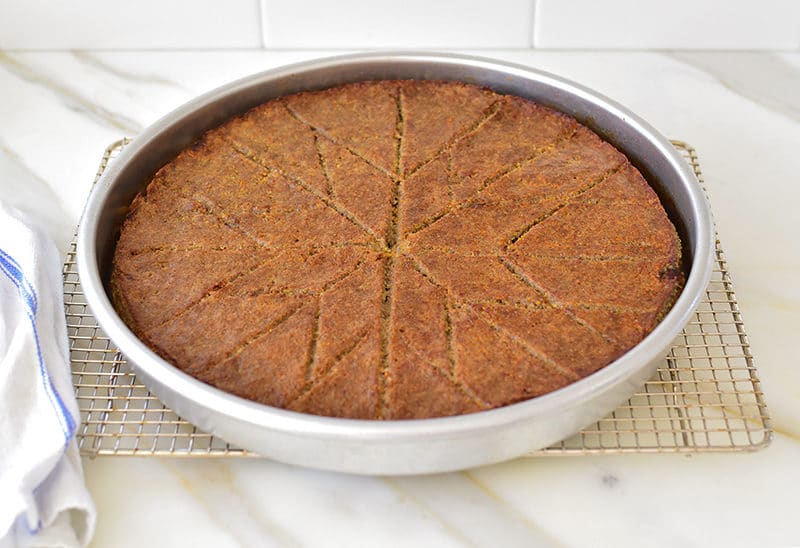
Few dishes make my family happier than Lebanese kibbeh. We always make kibbeh when the whole big clan comes together, so it always feels like such celebration food. My mother made kibbeh for special occasions too, always at Christmas, Easter, and homecomings of her five children. My husband Dan’s family does not celebrate anything without kibbeh, in the style of his mother Louise who included kibbeh on the table with about six other main dishes and a million other sides, dips, and more. Kibbeh is often part of mezze, served among many small plates at Middle Eastern restaurants, and kibbeh is centerpiece feast food!
Table of Contents
What is kibbeh?
Kibbeh, the national dish of Lebanon, is a dish of ultra-lean ground lamb or beef, bulgur, onion purée, and spices. Baked kibbeh is casserole-style with layers, with a cooked mixture of onions, ground lamb or beef, spices, and pine nuts as a filling. The variations of kibbeh are many, including vegetarian kibbehs, as well as kibbeh balls (stuffed) and fried.
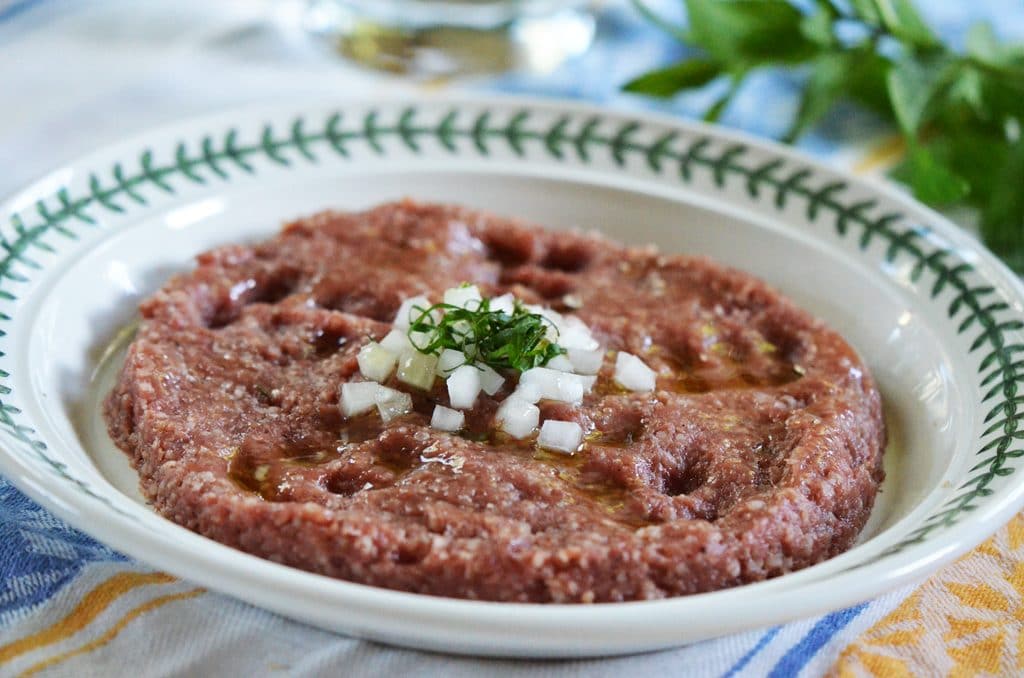
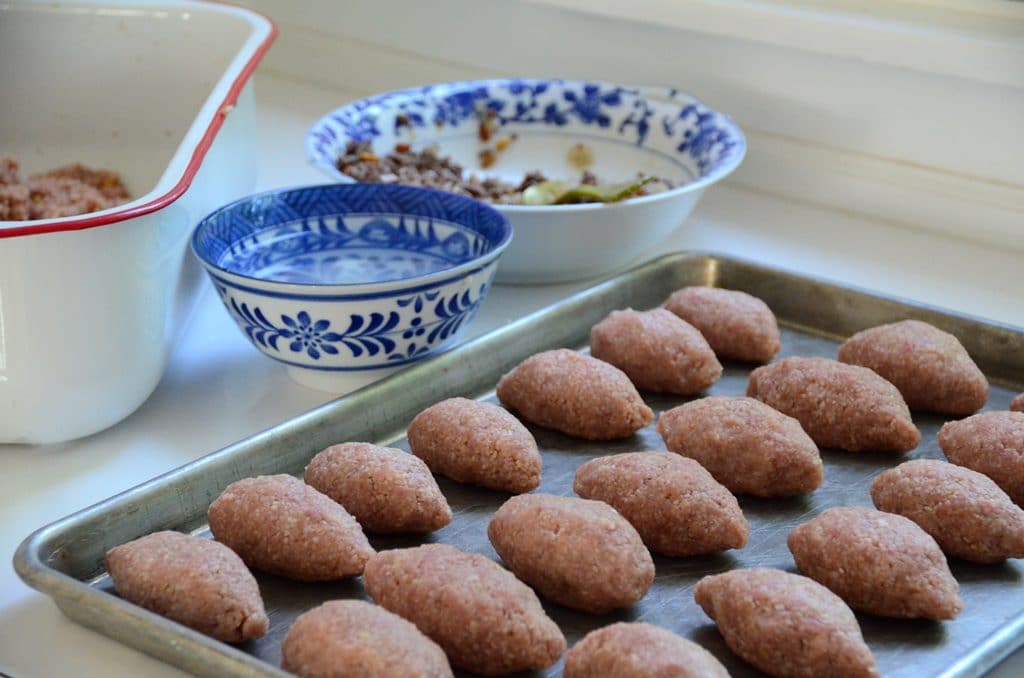
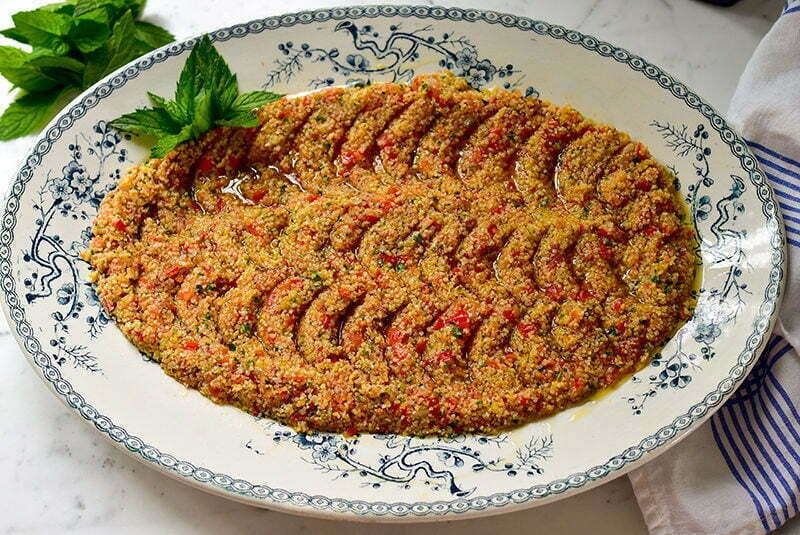
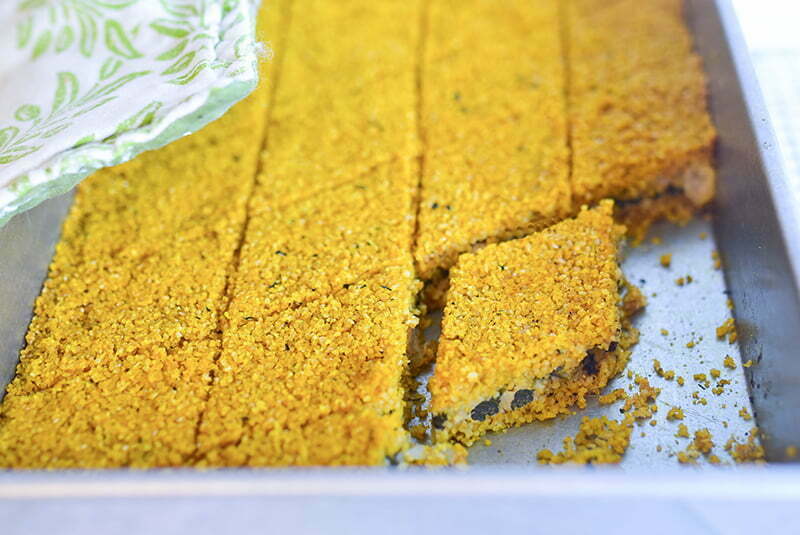
Types of Kibbeh
There are many deletable versions of kibbeh, from meat-based to vegetarian, all of them traditional Lebanese recipes. Here’s a run-down:
Baked kibbeh, Kibbeh bil sanieh is stuffed kibbeh in a baking sheet or other baking dish.
Raw kibbeh Kibbeh nayyeh, is like steak tartare, but with finer ground meat.
Kibbeh labanieh is kibbeh balls with warmed yogurt sauce (Lebanese laban).
Arras kibbeh is kibbeh in a football shape, are fried (and sometimes, grilled).
Patties, with no filling, fried in hot oil, make the simplest version of cooked kibbeh, and so very delicious.
What do you eat with kibbeh?
Kibbeh is delicious as a main course. Serve kibbeh with pita bread (try making homemade pita bread), Yogurt Cucumber Salad (the Lebanese version of a tzatziki sauce, similar flavors), and a crisp green salad such as Fattoush salad. Kibbeh is part of the mezze, or small plates, enjoyed with a wide array of dips such as hummus and baba gannouj, and salads such as tabbouleh.
Ingredients for Baked Kibbeh
Ingredients for the kibbeh:
Fine Bulgur. Also known as #1 bulgur, fine bulgur does not need to be cooked; simply soften in water.
Lamb or beef, finely ground. Use leg of lamb or beef eye of round. Both lean beef and ground lamb are great options for kibbeh meat. Ask a butcher to grind the meat twice for you, first removing all fat and gristle.
Salt and pepper.
Sweet onion. Puree the onion in a food processor so it becomes a ‘binder’ for the mixture of ground meat.
Ice water. Have a bowl of it close by to make sure you have damp hands while you knead. Keep wet hands by dipping into the water bowl as you go. Take care not to do it too many times, or the kibbeh will get mushy if you use more than just a little water.
Spices. There are many ways to season kibbeh, with 7 Spice (baharat) or your own blend. I use my mother’s seasoning: cinnamon. My husband Dan’s family uses cinnamon and a hit of cayenne pepper. You can also include allspice.
Fresh mint, as a garnish.
Ingredients for the filling (househ or hashweh):
Olive oil. Some for the recipe, and some to coat the pan.
Yellow onion, diced
Ground beef or lamb
Cinnamon, salt and pepper
Lemon juice
Pine nuts
Butter. A small dab of butter on each square or diamond of kibbeh before baking adds savory flavor, color, and moisture
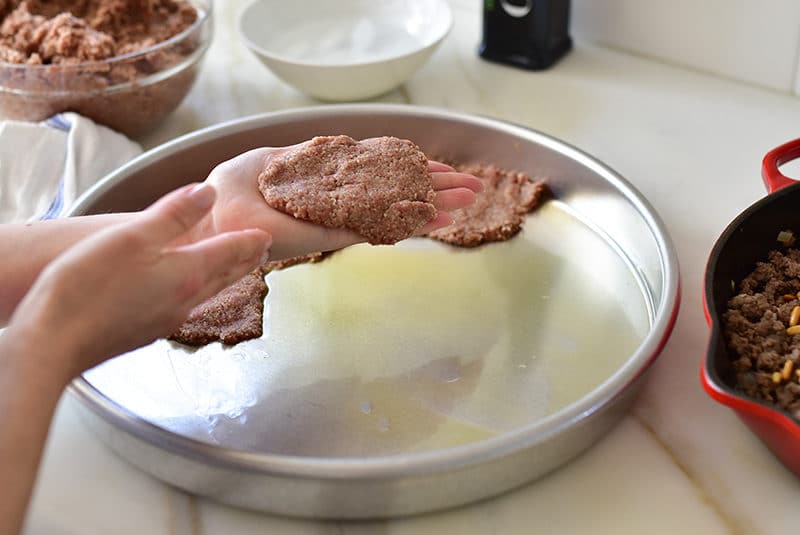
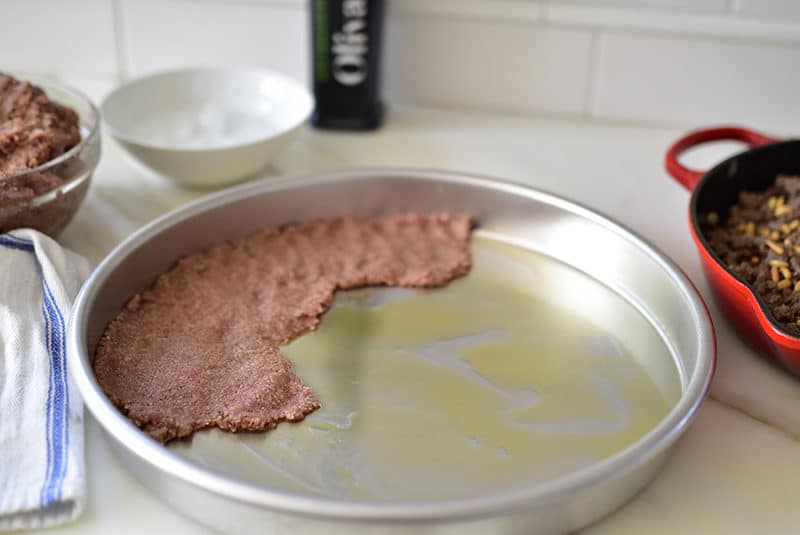
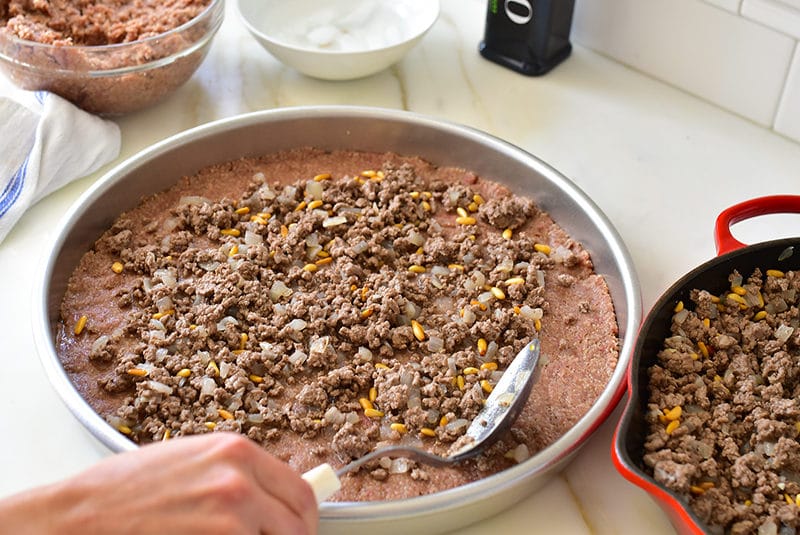
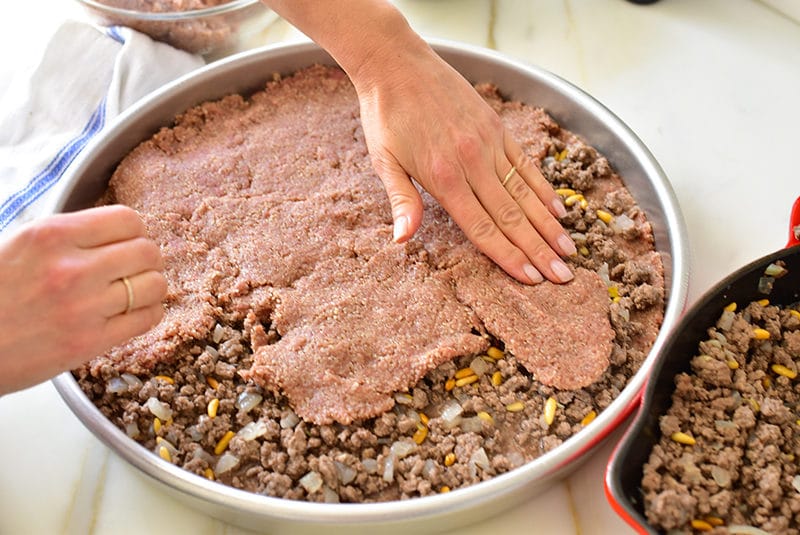
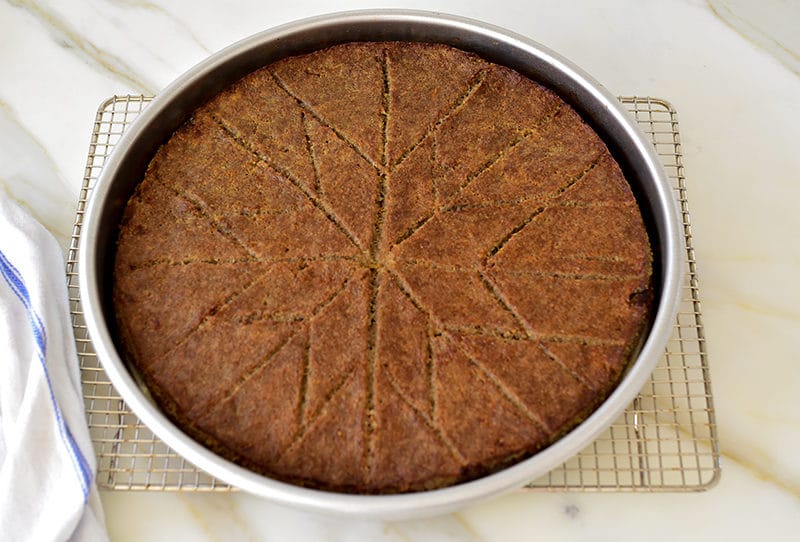
How to make Baked Kibbeh
Make the kibbeh
Step 1. Rinse the bulgur in cold water, drain, and cover again with cold water. Soak for half an hour, or until the bulgur is soft.
Step 2. To grind the red meat, slice it into rectangles, about 4×2 inches in size. Season lightly with salt and pepper and freeze for 30 minutes. Grind the meat once on the fine/small holes on the grinder, or twice on the large holes. You can also ask a butcher to grind the meat for you, make sure they grind it three times on sterile blades!
Step 3. To combine the kibbeh meat, keep a small bowl of ice water nearby to keep hands wet and cold. In a large bowl, knead the meat with the pureed onion, and about half of the cracked wheat. If there is any visible water left in the bulgur from soaking, squeeze the bulgur before adding it to the kibbeh. Be careful not to add too much water or the kibbeh will become mushy instead of soft, no more than ¼ cup. Add the bulgur ½ cup at a time until fully incorporated. Season with salt, pepper, cayenne, and cinnamon.
Make the baked kibbeh filling:
Step 1. Place a large frying pan (or large skillet) over medium heat and warm the olive oil until hot but not smoking. Add the onions and half a teaspoon of salt, sauté until soft. Add the ground beef, season with cinnamon, another half teaspoon of salt, a few grinds of black pepper. Cook the meat mixture until browned, breaking up the meat with into small bits as it cooks.
Step 2. Finish with lemon juice and pine nuts, off the heat.
Layer in the pan:
Step 1. Preheat the oven to 400°F.
Step 2. Coat a 13x9x2-inch rectangular pan or 10- to 14-inch round baking pan lightly with oil. Set up a small bowl of ice water where you are working and use the water to coat your hands as you flatten and shape the kibbeh. Use half of the kibbeh to press a thin, flat, single layer covering the bottom of the baking dish.
Step 3. Spread the filling evenly over the layer of raw kibbeh.
Step 4. Make the top layer of kibbeh using about a cup of kibbeh at a time. Moisten your hands with cold water from the bowl, and flatten the kibbeh between the palms of your hands. Make thin disks this way, and lay them over the top of the filling in the pan, nestled directly next to each other. Smooth the seams with cold water, pressing in bits of kibbeh to any openings where needed.
Step 4. Use the tip of a sharp knife to score the top layer in squares (or the traditional diamond shapes) , cutting through to the center layer, but not all the way to the bottom of the dish.
Step 5. Place a dab of butter on each square—this adds a wonderful savory flavor and moisture to the kibbeh. Bake in the center of the oven for about 50 minutes, or until the kibbeh is deep golden brown on top. Place the kibbeh under the broiler if needed, for additional browning.
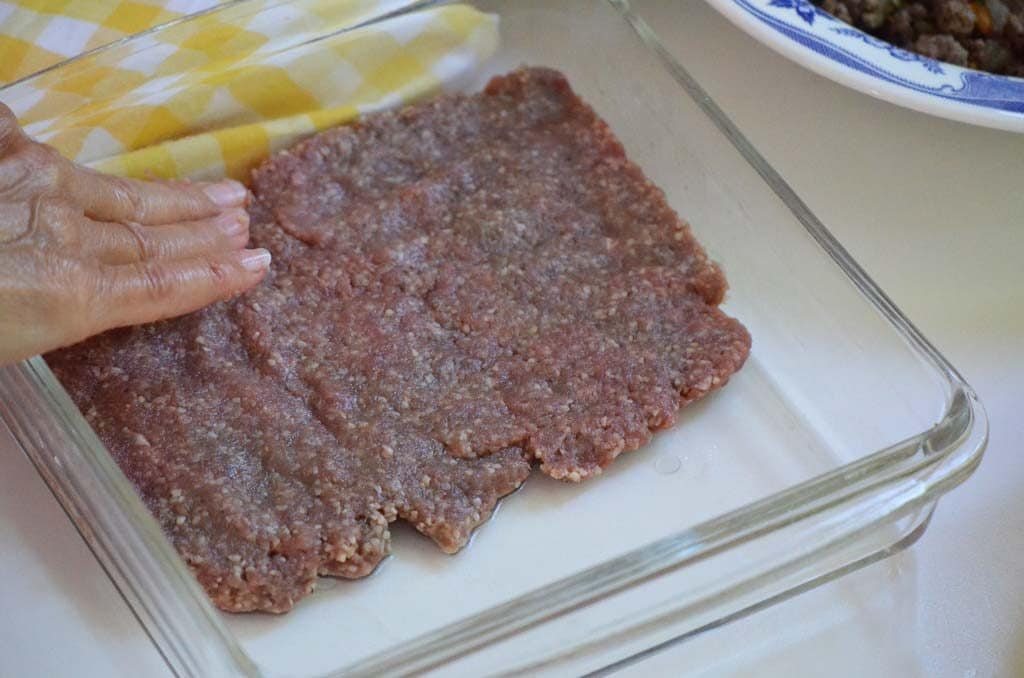
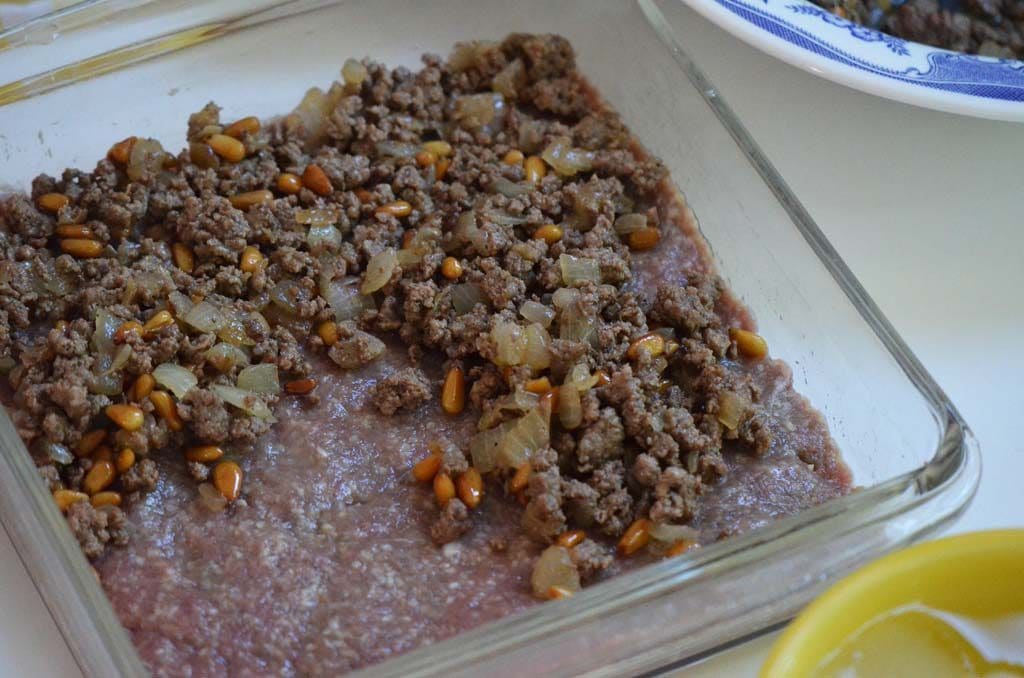
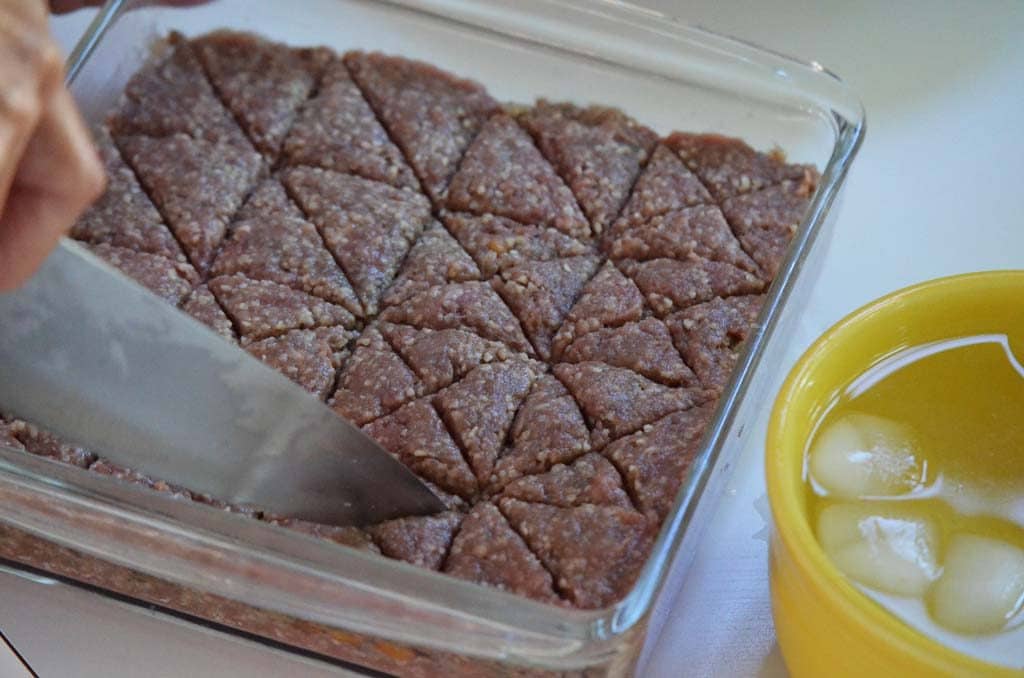
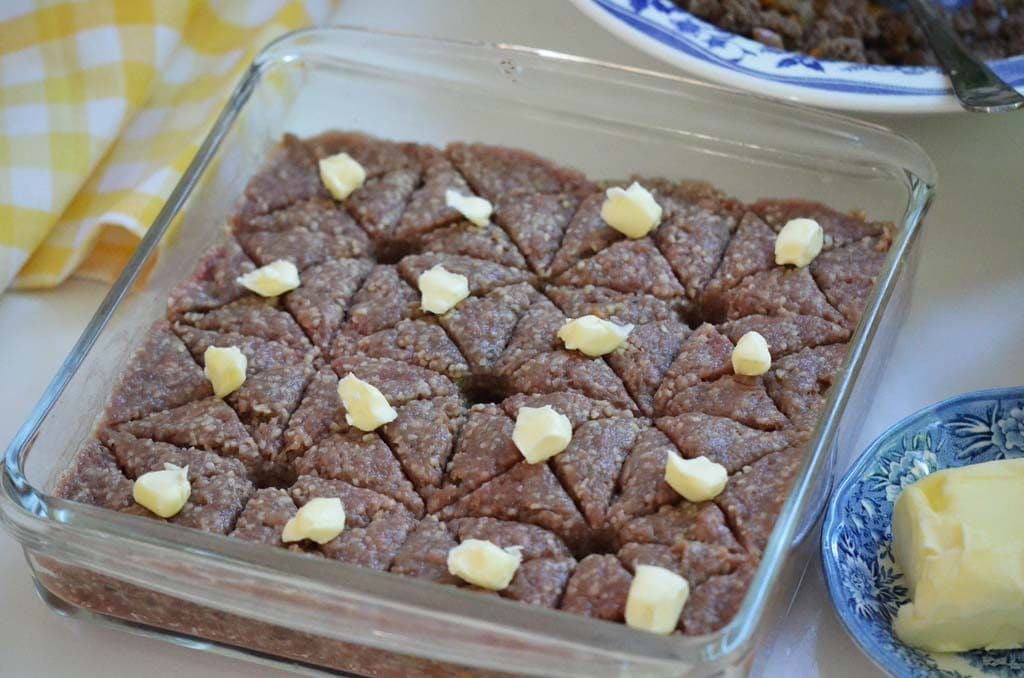
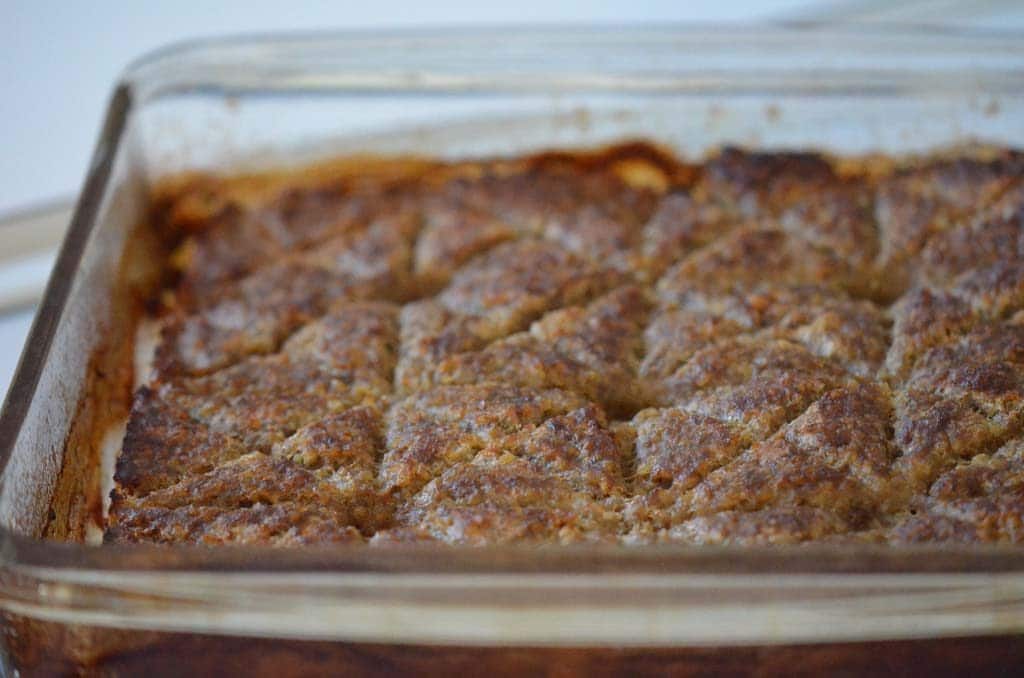
Tips for making Baked Kibbeh
- Broil the baked kibbeh to get a golden brown color on top.
- Brush the top with oil (olive oil or a neutral oil such as avocado) toward the end of baking to help with browning, and again before serving to make the kibbeh fresh and moist.
- Use wet hands to flatten the kibbeh in the pan, the top and bottom layers.
- Don’t make the kibbeh layers too thick. Aim for 1/2-inch thick layers top and bottom.
- Press the top layer of the kibbeh down with the palms of your hands to make it cohesive.
Variations for Baked Kibbeh
- For a gluten-free version, use quinoa instead of bulgur. Be sure to rinse and cook the quinoa as directed.
- There are spice blends specifically for kibbeh, called kamouneh. Use this, Lebanese 7 Spice, or your own combination of Middle Eastern spice flavors such as cinnamon and allspice. Dried mint is traditional too.
- Make this nut-free by leaving out the pine nuts. Or, also common in Lebanese cuisine, substitute the pine nuts with toasted slivered almonds.
Frequently Asked Questions
The meat versions of kibbe include ground beef or lamb. Many cooks grind their own meat for kibbeh because it must be free of any fat or gristle. A butcher can handle this labor intensive process for you!
Use quinoa instead of bulgur for a gluten-free version of baked kibbeh.
You can definitely bake half the kibbeh the first time using a smaller pan, store the rest in the freezer, and use at another time. You don’t always have to make the full recipe at once!
Kibbeh is mixture of lean meat, bulgur, onion, and spices, while kafta is a mix of meat with higher fat content to keep it moist, and a few different herbs and garlic! Both are core middle eastern cuisine dishes.
A drizzle of Pomegranate molasses is delicious on kibbeh, and fresh herb garnishes such as mint, fresh basil or parsley add color and freshness.
Kibbeh keeps very well in the freezer, be sure to use plastic wrap over it to protect the meat from freezer burn.
Store in an airtight container in the refrigerator and it will keep for up to five days. Reheat in the oven or microwave; refresh with oil on top.
Kibbeh made with meat contains protein and all kibbeh includes bulgur, which is a high-protein and high-fiber grain.
More kibbeh recipes to try
All of the Lebanese Kibbeh Recipes You Need
This isn’t kibbeh but my mujadara recipe uses bulgur to great effect. Try it!
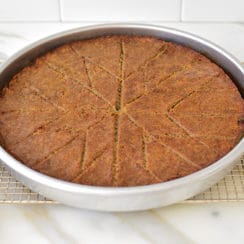
Lebanese Baked Kibbeh
Ingredients
For the kibbeh layers:
- 1 cup fine bulgur
- 1 pound leg of lamb or eye of round beef, trimmed entirely of all fat and gristle, and ground three times
- 1 medium sweet onion, puréed
- 1 tablespoon table salt
- 1/2 teaspoon ground black pepper
- 1 teaspoon ground cinnamon
- 1/4 teaspoon cayenne pepper
For the filling:
- 1 tablespoon extra virgin olive oil, plus more to coat the pan
- 1 medium yellow onion, diced
- 1 pound ground beef from chuck
- 1/2 teaspoon cinnamon
- 1/4 teaspoon cayenne pepper
- 1 teaspoon kosher salt
- 1/4 teaspoon ground black pepper
- Juice of 1/2 lemon
- 1/2 cup pine nuts, toasted
- 2 tablespoons cold butter, cut in small pieces
Instructions
Make the kibbeh:
- Rinse the bulgur in cold water, drain, and cover to 1⁄2 inch with cold water. Soak for 1⁄2 hour, or until the bulgur is soft. If there is any visible water with the bulgur after soaking, squeeze it out of the bulgur before adding the bulgur to the kibbeh.
- Place an oven rack in the middle of the oven. Heat the oven to 400°F.
- Set a small bowl nearby filled with ice water, to soften the kibbeh mix and to wet your hands while you work. In a large bowl, knead the meat with the pureed onion and about half of the soaked bulgur. Dip hands in the cold water as you knead, adding about 1⁄4 cup of the water in total; be careful not to add too much water to the kibbeh or it will become mushy rather than simply soft. Add the rest of the bulgur and mix until it’s fully incorporated. Add the salt, pepper, cinnamon and cayenne, "kneading" the kibbeh to mix evenly.
Make the filling:
- In a large sauté pan, warm the olive oil over medium heat until hot but not smoking. Add the diced onion and a half teaspoon of salt and sauté until soft, stirring occasionally. Add the ground beef and season with cinnamon, another half teaspoon of salt, and a few grinds of pepper. Cook until browned, breaking up the meat with a metal spoon into small bits as it cooks. Squeeze the lemon juice over the meat mixture. Stir in the pine nuts and set aside to cool.
Assemble the kibbeh:
- Coat a 9x13x2 inch or 10- to 14-inch round baking dish with oil. Set up a small bowl of ice water where you are working and use the water to coat your hands as you flatten and shape the kibbeh. Use half of the kibbeh to form thin, a flat layer covering the bottom of the baking dish. Smooth the layer with cold water.
- Spread the stuffing evenly over the flat kibbeh layer. Using the remaining kibbeh meat, form another thin, flat layer over the stuffing and smooth with cold water. Do this with about 1/2 cup of kibbeh at a time, flattening and laying into the pan. Dip your fingers in the cold water to smooth over the seams and press the top layer gently into the filling layer.
- Using the tip of a sharp knife, score the top of the kibbeh in squares or a traditional diamond pattern, cutting through to the center layer but not all the way to the bottom of the dish.
- Place a dab of butter on each square or diamond—this adds a wonderful savory flavor and moisture to the kibbeh. Bake in the center of the oven for about 50 minutes, or until the kibbeh is deep golden brown on top. Place the kibbeh under the broiler for a few minutes to encourage a crusty deep golden top.
- Cool for about 10 minutes before cutting and serving.
Video
Nutrition information is automatically calculated, so should only be used as an approximation.

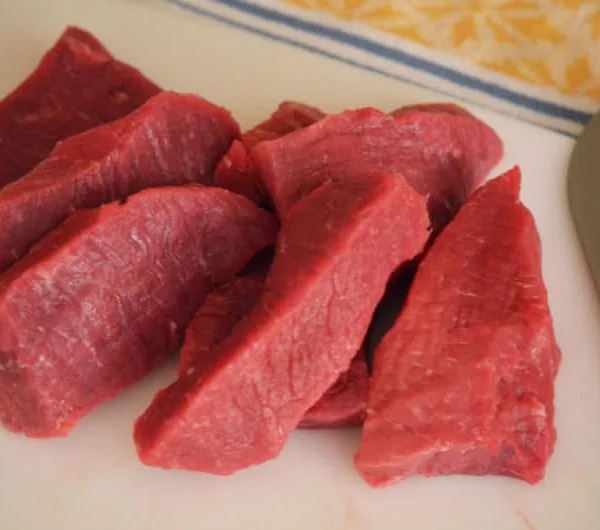
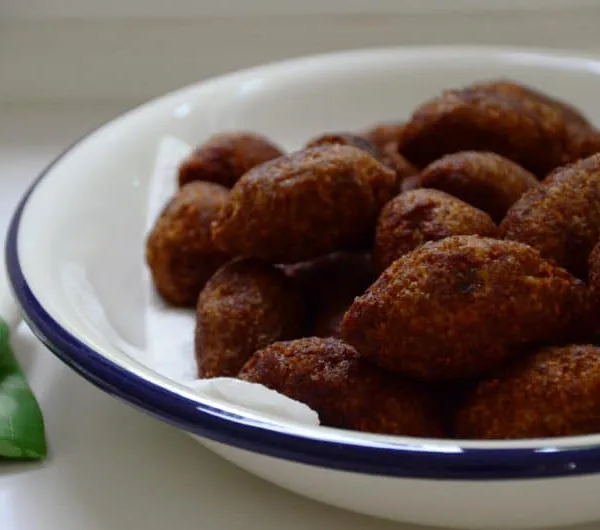
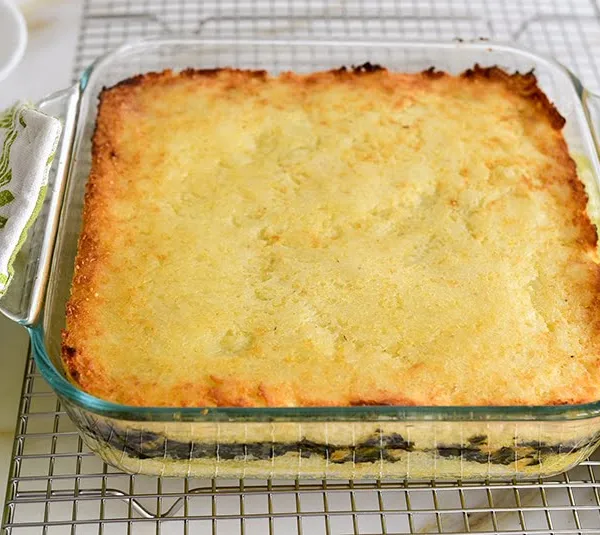







I’m a little confused. Your recipe calls for cinnamon, cayenne pepper and pine nuts, yet I don’t see you using those ingredients in your video. I know my mom used pine nuts, probably not cayenne and maybe a little cinnamon, nutmeg or allspice, although I don’t remember those flavors unless they were very subtle. It’s been over 20 years that my Syrian mom and aunts have been gone. How I miss the food I grew up on and how sorry I am I never learned to cook their recipes, which were of course in their heads. Now I have a friend who got her first taste of Mediterranean cuisine at a restaurant. I’d like to introduce her to some authentic recipes so now I’m on a quest and so happy to have stumbled onto your website.
Hi Cecile! Yes, my recipe evolved over time and yet the video was not re-done! Thank you, I’ll get there! I am so happy you are on a quest to learn and cook these recipes. I’ll love to hear what you’re making!
Very nice kibbeh
Thank you Nelly!
Great recipe, but where is the humsa? The cooked lamb to dip the kibbeh in? We are from Douma (Duma). Perhaps each village has its own way of serving this wondrous food. But the humsa adds a great touch.
Great site. Thank you so much.
Virginia Sawaya
Virginia I love this comment so much. We make “househ” but my cousins and I have discussed and it’s not the same as humsa–which has tomato in it, correct? I need to develop the recipe for my site!
Maureen: Your recipes are WONDERFUL! I’m 1/2 Lebanese on Dad’s side and my Mom (Scottish/American) was an extraordinary cook and lady, and she made all of the famous Lebanese dishes…kibbee, lubieh bil lahme…etc…etc. She learned from Dad’s Mom who didn’t speak English, so I’ll never know how they communicated, but they did. Now, I have to make them myself and rely on your recipes. In any event, I just wanted to compliment you on your site and recipes. I hope to find a great Leb girl similar to you to marry! How I wish that you had a single twin… God Bless you and your lovely family.
Dave what a great story you have!! Thank you for your high compliments, I’m so touched…May God bless you with every gift of love your heart desires and a wife to love deeply.
My whole family is Lebanese, we never put hot pepper in kibbe. Onions soft & smashed cinnamon. Salt a little black pepper a good bit of Allspice. Then of corse the filling also onion cinnamon salt pepper pine nuts & again allspice. I made a big pan & in the frig. Waiting for family dinner tomorrow. Also Leban & cucumber garlic & bit of fresh lemon also made Tabouli for everyone. I got your orange water for Easter to make sweets for Easter Sunday.
Maria your family dinner sounds DIVINE!! We never used the hot pepper either but my husband’s Shaheen family made me a convert on it…! I’m excited for all of our Easter baking with gorgeous orange blossom water….
Hi Maureen,
My kibbeh shrinks in the pan too much. While it tastes good, IMHO LOL, it doesn’t look as good. Any suggestions?
BTW, your recipes are awesome.
Jerry thank you–the shrinkage is definitely a thing. I think something that helps is additional bulgur in the kibbeh “dough” for baked kibbeh. I’m going to work on this question and see what else I can come up with…. Meanwhile, I serve the kibbeh not from the pan, but in cut pieces on a platter so no one can see how it shrank!!!
I printed your baked kibbeh (1/2 recipee) . In the picture, it looked like you used a 8 x 8 or 9 x 9 dish. the recipee states 9 x 13. pan. Before I attempt this recipee, which pan is appropriate for the 1/2 recipee? Thanks
Shelby good question–my baked kibbeh recipe (using 1/2 recipe of my kibbeh recipe) is for a 13x9x2 pan. My pan in the photos is a larger pan but not rectangular 13x9x2. Enjoy! Love to hear how it goes!
Hi Maureen. Your recipe is great. All your recipes remind me of what we were taught and still make. Shukran. This is the Kibbe with which I grew up and still make. It was our dish for Eid 2019. I am half Syrian (father) and half East Indian descent from Trinidad (mother). My father’s cousins and a brother also migrated to Trinidad. So one of his first cousins taught us to cook Syrian food. Aunty was a specialist Coobz baker and she use to have my Uncle delivering to all the Syrian stores in Port of Spain on a daily basis. It became their business. She also cooked daily meals for the single Syrian men who stopped for a hot homemade meal close to their heart and homeland.
Keep up the good work.
This is beautiful, thank you so much Nazira for sharing.
Thank you so much for this recipe! My husband’s mom was Lebanese and I can’t wait to make this for him. I also just got your cookbook on Amazon and look forward to trying out more of your recipes.
That’s so great Jamie, thank you! Let me know what you’re making!
Hi Maureen! I was wondering if you have any tips on making this ahead (Christmas Eve, for Christmas Day). Would you make it up to the point it goes into the oven, and then refrigerate and bake the next day? Or would you bake it and reheat the next day?
Hi Clare–I’m making mine ahead too. I always freeze the sahnieh raw, and then bake it straight from the freezer. It may take a little longer to bake, but not by much (I’ve been making my sahnieh very thin and it comes out great that way). Wait to dab the butter on top until just before baking. I’m sure you could also refrigerate overnight rather than freeze, and that would work great too!
My mother always shooed us out of the kitchen so we never learned our native dishes. She was a fabulous cook. Here I am now 68 years old trying to recreate her dishes. I am a chef or was until a few years ago. It’s a fun game. Your recipes seem to give me a taste like hers. Thank you
That means a lot Michael, thank you.
I stumbled upon your site today and felt a warm hug from family members long since past. My mother was adopted into a family from the middle East and our recipes lay somewhere between Lebanese and Syrian cooking.
My mother and I were two (very white) blonde haired, blue eyed girls in this colorful, loud, loving, wonderful family who shared all of these foods and traditions with us. I miss them terribly.
Over the years we have tried many variations on the classic kibbeh (almost exactly as this recipe). However, our version is with allspice, not cinnamon. Is allspice a common spice for you?
In addition, we have also done a gluten free version for a family member using quinoa, which must be soaked just as the bulgur, but for a longer period of time.
We also even did a paleo version (grain free that happens to be low-carb friendly) using finely ground and soaked walnuts, still incorporating pine nuts into the middle filling layer. This added an extra buttery richness from the fat of the walnuts that was delicious!
Thank you for sharing these foods of love with the world. I wish everyone could have grown up with them!
How special in every way, Erica–thank you for sharing! Allspice does make its appearance–my aunt uses it quite often in addition to cinnamon. I wonder though too if it’s more typically Syrian? I love your kibbeh ideas with quinoa and the walnut version! So clever. I will try them!
All four of my grandparents migrated from Lebanon, and my Sitties were excellent cooks, as was my beautiful Mom. I have been looking for a carb friendly alternative for kibbe, and I was thrilled to read your walnut variation. I can’t wait to try it. I have also been thinking of making stuffed grape leaves using cauliflower rice. What do you think? Thank you!
Michelle hi! “Cousin”! I love the cauliflower rice idea for the grape leaves. It should hold up well, like rice. Let’s both try it and report back!!
When my daughter needed to be gluten free I replaced the bulgar with Quinoa.
Excellent. How did it perform? Did you rinse and soak the quinoa before using it, the way we do bulgur?
After unsuccessfully seeking ground lamb from a number of sources, I was usually able to find a leg of lamb at Costco. Then I prefer to grind the leg of lamb myself using clean blades. I really like to taste the raw kibbeh mixture during preparation to assure there is the right amount of seasoning.
Thank you for the recipe. I am looking forward to your book. My grandfather was born in Haifa and immigrated to Dom Rep where he married. My mother carried on the tradition of cooking the Lebanese food my grandfather was so fond of. But she past 7 years ago. I am now trying to recreate the wheel in order to find recipes for those special dishes I so enjoyed. I do remember my mother used to add chopped fresh parsley to her meat filling. Is that not traditional? My mom was known for adding her “twists” to recipes.
Thank you Raquel–I have seen fresh parsley in the kibbeh, but not often. How delicious. I will try it this summer! Keep up the great work carrying on the tradition of making our Lebanese specialties!
We use to stir fry about a pound of ground lamb, finely chopped onion, pine nuts, and cumin and used a full teaspoon of that mixture to stuff the kibbeh before frying the ovals…really yummy and special treat in the middle 🙂
ok– so i got back on the “kibbeh with stuffing” horse today–using your recipe…and while the taste was FANTASTIC– the layers, as always–did not stick together! i don’t know what i’m doing wrong, and it’s making me crazy!!!!!! i cut into the pan of beautiful, crusty baked kibbeh–and it falls apart… 🙁 help!
Hmmm, I think that the kibbeh often wants to fall apart, and you just put it together on the plate. Maybe your pieces are a little too small? Also, the top and bottom layers of kibbeh shouldn’t be too thick. Press the top down into the househ layer too. I understand the crazy! Hope these tips help. Let me know!
Hi Maureen,
I also love cooking, a trait passed on by my (Irish) mom who learned to cook Italian dishes from my dad’s mother and Lebanese dishes from her best friend whose family owned a restaurant in Brooklyn, NY. Some of mymost favorite childhood memories revolve around the evenings we all had dinner at the restaurant and the amazing dishes prepared especially for us. I am thrilled to find recipes on your site to indulge myself and share with my friends. Thanks for your time and effort in bringing these dishes to those of us who have forgotten some of the finer points of Lebanese cooking. Carina
Beef? Come on! It has got to be lamb!!! Beef is a cheap way to cut corners, it is a bastardization! No Lebanese I know would be caught dead using beef for Kibbe!
I love your passion, Megan! Come on up to Michigan and you will meet many Lebanese who use beef for kibbeh…it is what I and many others in my hometown grew up on, even in restaurants here. That, I believe, grew out of the lack of availability of quality lamb meat year round.
I live in the Upper Peninsula of Michigan. It is very difficult to find lamb up here. When you do find it, it’s very expensive, but I’m willing to pay for it when I can get it. Although I think kibbeh made with lamb is far superior, I’d rather have it made with lean beef than not have it at all.
I live in Illinois just outside of Chicago and also have family downstate Peoria Illinois (Huge Lebanese community) and ALL of us use good beef instead of lamb Megan!
I found that if you can’t find bulghur you can use couscous as an acceptable replacement. My children actually like it better. It should also be mentioned again the the bulghur needs to be soaked, or I have seen water added to the mix and the wheat soaked up the water from the mix.
As with most old school cooks, both my mother and grandmother went by sight and taste rather than measurement. The standard was a 50/50 mix of wheat and meat. by sight. It always seemed like a lot of wheat before it was mixed but always came out.
We also add nutmeg and black pepper to the mix.
Couscous, wow!! The old school cooks did it so much that they barely needed to open their eyes in the kitchen!! Thanks and loved your comment.
Maureen,
Your presentation is as elegant as ever! Thank you for the recipes.
-Gary
Thanks for being here Gary!
So enjoyed reading this; you are providing me with delicious bites of culinary education in a subtle way. It’s woven into stories and photographs; maybe like househ stuffed into kibbeh sahnee, if I understand you correctly? And pleasurably: my favorite line here: “What is with the meat bonanza?” Glad to be here to enjoy it all.
Nancie, I love knowing that you are with me here . Yes–househ stuffed into kibbeh sahnee!
Still to this day, women in Lebanon are judged by their kibbeh…funny! Yours look great and would definitely land you a few marriage proposals! 🙂
Fantastic Joumana! I’ll head over asap!!!
When do you have a cookbook coming out! should be a good one…
Thank you! Working on it….I will keep you posted….
Hi Maureen, one of my favorite dishes! I fry clarified butter n pine nuts n spread on first layer n put second layer on top sometimes walnuts. So super
Ohhhh that sounds excellent, thank you so much!